Poisonous Salamanders: Are They Dangerous?
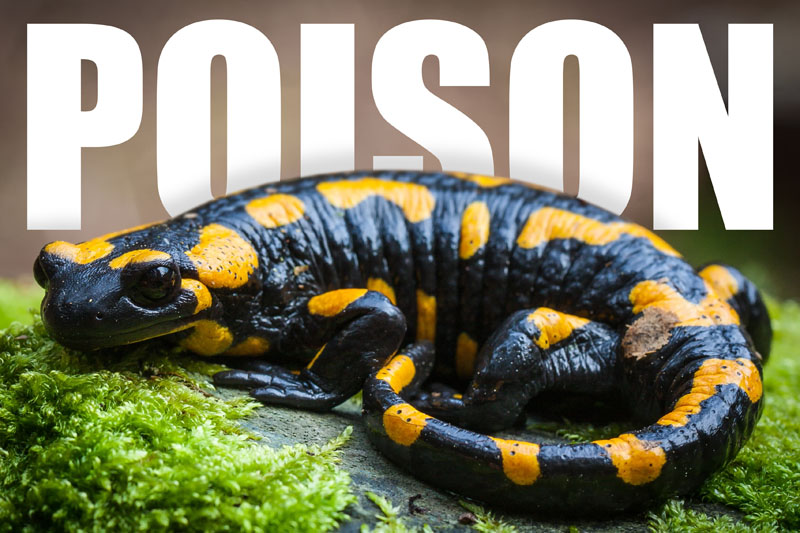
The topic of poisonous salamanders is really interesting. Their skin is fascinating because it has a thin layer of mucous that contains toxins. The sticky, slimy layer is there for two reasons. One part protects them from microorganisms and the other protects them from predators.
It’s the predator protection part that is most concerning for us. After all, a potent toxin (poison) is a reason for concern, especially if you’re likely to come into contact with a salamander or want to keep one as a pet.
Anyway, I’ll quickly dispel concerns by summarizing the poison secretions of salamanders in the following paragraph.
All salamanders are different and some produce more potent toxins than others. Naturally, some are more dangerous than others. Also, there are both poisonous and venomous salamanders but more on that later. For now, learn why salamanders are poisonous.
Table of Contents
Why Amphibians Have Slimy, Poisonous Skin
I briefly mentioned this in the opening paragraph: Amphibians have a thin layer of mucus covering their skin and there are two reasons for this.
Amphibians have unprotected skin. It is not covered by scales, feathers, or fur. Moreover, their skin is semi-permeable. This means their skin allows things to pass through it. For example, amphibians are capable of absorbing oxygen from the water through their skin.
Just because an amphibian’s skin is unprotected by feathers, fur, or scales, doesn’t mean it’s completely unprotected. That’s where the layer of mucus comes in.
Protection from Microorganisms
Many amphibians spend their lives navigating humid, moldy environments. In these environments, microorganisms such as fungi and bacteria are prevalent. Without protection from these microorganisms, they wouldn’t last long.
Studies conclude that the mucous layer has an antibiotic function to prevent infections. One study aims to determine if salamanders are susceptible to Batrachochytrium salamandrivorans (BSAL) [1], a deadly pathogen partly responsible for decreasing populations of salamanders.
This layer of mucous is found in granular glands and mucous glands, which are distributed across the entire skin of an amphibian. Both glands are vesicular. A vesicle is a membranous and typically fluid-filled pouch. Meanwhile, the granular or poison gland is usually bigger than the mucous glands.
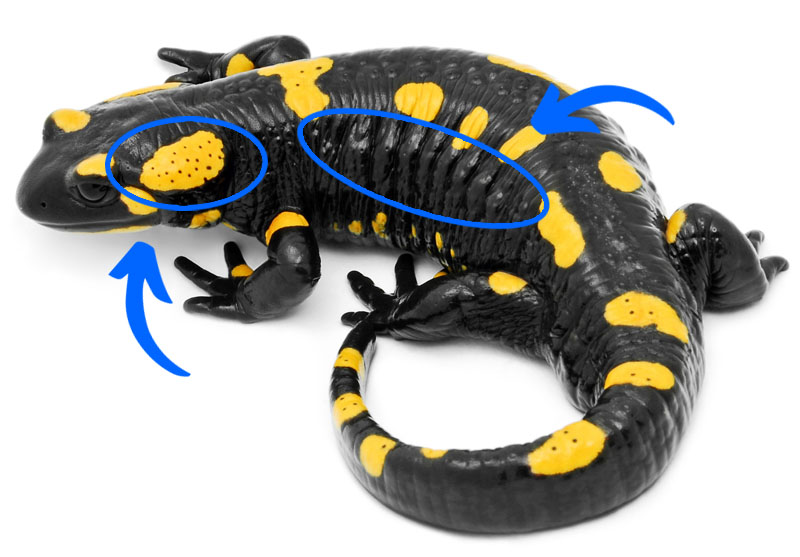
Protection from Predators
Aside from protection against microorganisms, amphibians have adapted toxic secretions in order to protect themselves from potential predators.
Consider a small animal like a coyote who stumbles upon an amphibian. Hungry for his next meal, it bites an amphibian and instantly gets a bad taste in its mouth. Irritation and swelling set in, leaving the coyote regretting his choice to bite the amphibian. The coyote is less likely to bite amphibians of similar appearance in the future.
This reaction is intensified when combined with aposematically colored amphibians. Aposematic is an adjective used to describe vivid colorations and patterns that serve as a warning to deter predators[2].
A good example of aposematically colored amphibians comes in the form of poison-dart frogs, which display a wide variety of bright, vivid colors. Since we’re mostly talking about salamanders in this post, I’ll point out the colors of the Fire Salamander in the picture above.
To wrap up this section, the toxins or poisons on/in salamanders are there to protect them from potential predators.
Unken Reflex in Salamanders
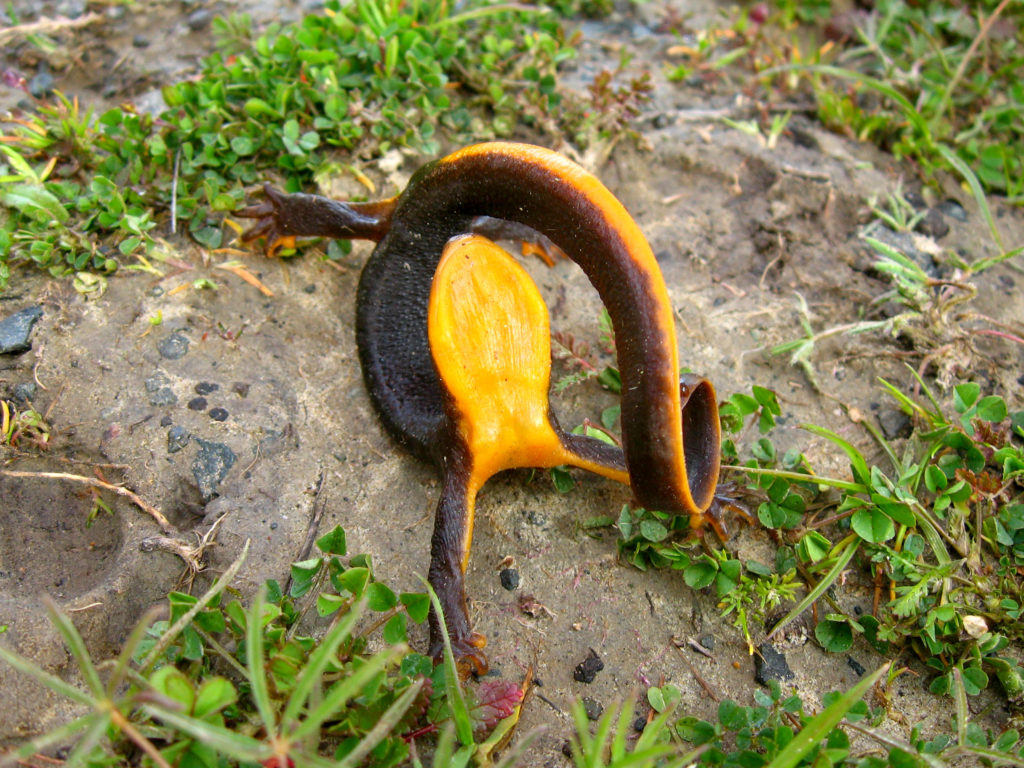
This topic wouldn’t be thoroughly covered without at least quickly mentioning “Unken Reflex” or “Unkenreflex”. A small number of amphibians exhibit this type of behavior in the face of danger. The purpose of the contortions is to reveal the otherwise hidden, bright colors.
As we just learned, aposematically colored amphibians have bright colors to warn potential predators that they’re dangerous. In the case of the California Newt in the photograph above, those bright colors are on its underside. The salamander exhibits unkenrelfex by contorting its body in a way that displays its bright colors. The posture and colors mean “Back off! I’m dangerous”.
Salamander Toxins: Poison & Venom
Now that we know why amphibians have mucousy, toxin-covered skin, let’s take a look at one of the most notable toxins found in salamanders as well as the two methods of delivery.
Tetrodotoxin (TTX) – A very potent neurotoxin found in members of the Taricha Genus, which are found along the West Coast of the United States.
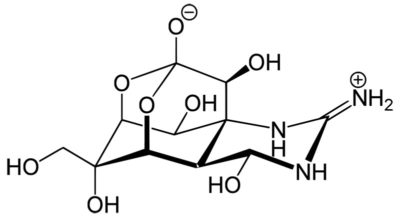
Four species in the Taricha Genus (containing tetrodotoxin):
- California newt
- Sierra newt
- Red-bellied newt
- Rough-skinned newt
Related fact: A newt is a semi-aquatic salamander (subfamily Pleurodelinae), capable of surviving in water and on land (terrestrial). Not all salamanders are capable of surviving on land.
This neurotoxin isn’t unique to amphibians, however. Chances are you know about the effects of tetrodotoxin from something else. Have you heard of the Fugu fish? It’s a highly-prized fish in Japan. Preparation of Fugu is only allowed by specially certified chefs because, when cooked wrong, it’s deadly.
Located in the spawn, embryo, and blood of these newts, tetrodotoxin is potent. Ingesting tetrodotoxin can prove fatal. One such incident happened when a young man followed through with a dare to swallow a newt [3]. The newt, as you may have already concluded, was a member of the Taricha genus.
I don’t mean to scare you away from salamanders or amphibians in general. Most are, in fact, harmless to humans. Having said that, it’s important to know the facts and exercise precautions when dealing with any animal.
Now let’s look at the two different delivery methods of toxins. After all, the delivery method determines whether a salamander is considered poisonous or venomous.
Most salamanders are Poisonous
For a substance to be considered poison it needs to meet two criteria. One is that it is capable of causing illness or death. The second is that it is absorbed or ingested.
Again, the substance must be harmful in such a way that it causes illness or death. Well, this is subjective. Consider that the same toxin can cause illness to a small cat but not a human. In this scenario, is the toxin considered poisonous to humans? It’s certainly considered poisonous to the cat.
Most importantly, poison, in the context of toxins found on salamanders, is considered such because it is ingested or absorbed. The majority of amphibians are considered poisonous. However, the following section will show you that some salamanders are venomous.
Some Salamanders are Venomous
Venom is a toxic substance that is injected. The injection typically comes from biting or stinging, via teeth (fangs) or stingers. Think of a snake as an example. The reason a snake is considered venomous is that it injects harmful toxins via fangs.
Fangs and stingers aren’t the only means of injecting toxins though. In class Amphibia, there are a handful of species that wield the ability to inject the toxins on their skin. Because this page is specifically about salamanders, I’ll show you two such groups of salamanders with this ability!
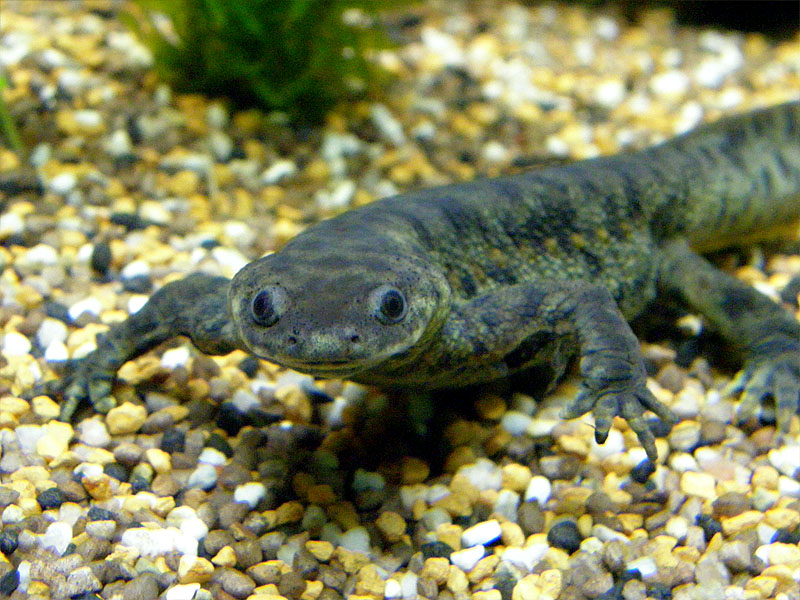
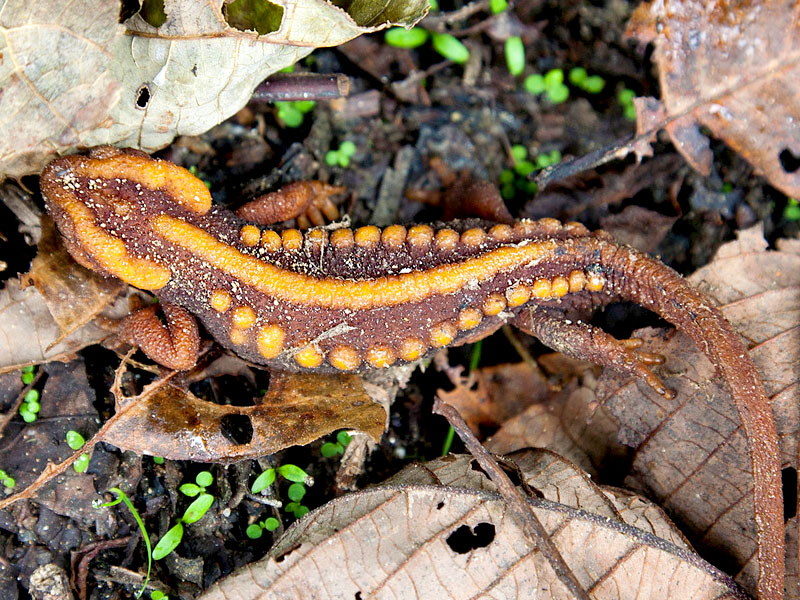
- Pleurodeles – This genus contains at least 3 species. They’re mostly found in Portugal and Spain.
- Tylototrition – This genus contains many species. They’re spread throughout Asian countries like Vietnam, Thailand, and Laos.
Both genera contain species having toxins in which they inject. Their delivery method is a bit unusual. They have sharp ribs capable of piercing the skin.
Should a predator bite one of them, their sharp ribs would pierce the skin. Having passed through their own skin, which contains harmful toxins, the salamander effectively injects the predator with toxins. With this in mind, these salamanders are considered venomous.
Related: Poisonous Frogs: A Complete Guide
Salamanders and Salmonella
I wouldn’t be doing my job if I didn’t warn you about the potential amphibians have to carry salmonella. While salmonella is technically a bacteria, it’s undoubtedly harmful and salamanders are capable of carrying it according to the Center for Disease Control and Prevention.
Salmonella is usually found in the digestive tract of amphibians. Coming into contact with their droppings is the most likely way of spreading infection.
For those of us who keep amphibians as pets, we typically do so by creating an enclosure suitable to their needs. The enclosures, however big or small, land or water, will have bodily droppings from your pet(s). It’s important to know the safety hazards of coming into contact the droppings (urine or feces).
This simply means salamanders are capable of carrying salmonella, not that all amphibians have it. Regardless, you should always wash your hands after handling amphibians and avoid touching your eyes and mouth.
Potentially Dangerous Salamanders in the United States
I’ve taken the liberty of creating a list of salamanders that are potentially harmful to humans in the United States.
| Image | Species | Location(s) |
|---|---|---|
 | California Newt (Taricha torosa) | US: California |
 | Rough-skinned Newt (Taricha granulosa) | US: California, Washington, Oregon Canada: British Columbia |
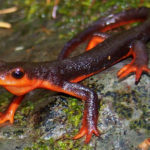 | Red-bellied Newt (Taricha rivularis) | US: California |
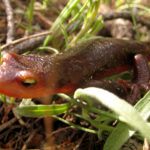 | Sierra Newt (Taricha sierrae) | US: California, Nevada |
These species are potentially dangerous to humans who do not use safety precautions. For small animals such as pet cats and dogs, who might see a salamander as an exciting thing to play with, they can be extremely dangerous! The toxins are more potent to small animals than they are to people.
Related article: Are frogs poisonous to dogs?
TLDR; Are Salamanders Harmful?
Salamanders are mostly harmless to humans. They do, in fact, have toxins on their skin. You’re in no danger by observing them and it’s mutually beneficial for you and salamanders that you don’t touch them. Regardless, the mast majority of salamanders are virtually harmless to humans.
- Rarely harmful to humans
- Dangerous to cats and dogs
If you simply cannot keep yourself from touching a salamander, there are a few things to know. The toxins on a salamander’s skin will likely be transferred to your hands. Don’t rub your eyes or touch your mouth until you’ve thoroughly washed your hands after handling the salamander. Also, salamanders can carry salmonella in their digestive tract. Salmonella is a harmful bacteria. Again, wash your hands after holding amphibians.
Do not eat salamanders. There is at least one confirmed fatality due to a man eating a salamander. Keeping salamanders as pets is a popular hobby and handling amphibians is rarely dangerous.
References
- Smith, H. K., Pasmans, F., Dhaenens, M., Deforce, D., Bonte, D., Verheyen, K., Lens, L., & Martel, A. (2018). Skin mucosome activity as an indicator of Batrachochytrium salamandrivorans susceptibility in salamanders. PLOS ONE, 13(7), e0199295. https://doi.org/10.1371/journal.pone.0199295[↩]
- Hofrichter, R. (2000). The Encyclopedia of Amphibians (Vol. 111). Gardners Books.[↩]
- Bradley, S. G. (1981). A Fatal Poisoning From the Oregon Rough-Skinned Newt (Taricha granulosa). JAMA: The Journal of the American Medical Association, 246(3), 247. https://doi.org/10.1001/jama.1981.03320030039026[↩]
